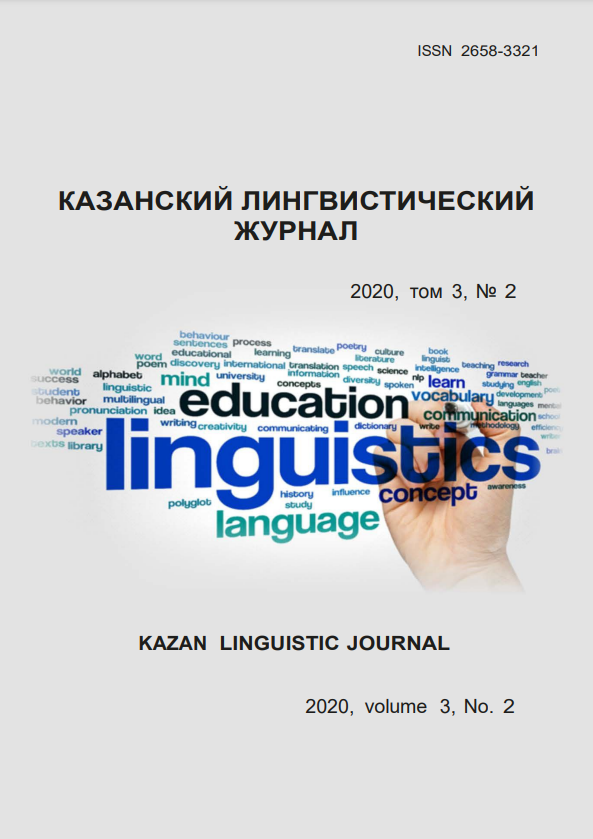SEMANTIC PROPERTIES OF MODAL VERBS 愿意 (yuànyì), 乐意(lèyì), 情 愿 (qíngyuàn) IN CHINESE
Keywords:
category of modality, desire, modal verb, modal meaningAbstract
This article explores the functional-semantic field of desire using modal verbs as an example. The subject of the study is the peculiarities of the modal verbs 愿意 (yuànyì), 乐意(lèyì), 情愿 (qíngyuàn), which have a semantic plan with a number of specific nuances, the understanding of which can diversify the practice of translation and teaching, and enrich everyday communication with additional clarifying meanings. In Russian, the word 愿意 (yuànyì) is translated as “to wish”, “to want”, “to be ready”, 乐意 (lèyì) is translated as “to want”, “to wish”, “to be glad to do something”, 情愿 (qíngyuàn) is translated like "to want", "to prefer something". In this paper, we study in detail examples of the use of the listed modal verbs and how to translate them into Russian, depending on the situation. The materials in this article can be used in teaching Chinese as a foreign language to speakers of other linguistic cultures, as well as in professional translation activities. A comprehensive approach to the study of modal verbs 愿意 (yuànyì), 乐意(lèyì), 情愿 (qíngyuàn) allows us to systematize the variety of their meanings.
References
Литература
Дешериева Т.И. О соотношении модальности и предикативности // Вопросы языкознания. 1987. №1. С. 34-45.
Золотова Г.А. О модальности предложения в русском языке // Научные доклады высшей школы. Филологические науки. 1962. № 4. С. 65-79.
Ваулина С.С. Модальность как коммуникативная категория: некоторые дискуссионные аспекты исследования // Вестник Балтийского федерального университета им. И. Канта. 2013. Вып. 8. С. 7-12.
Давлетбаева А.Ф., Фаткуллина Ф.Г. Особенности терминологической номинации категории модальности в китайском языке // Филологические науки. Вопросы теории и практики. 2019. Том 12. № 10. С. 252-257.
Фаткуллина Ф.Г., Давлетбаева А.Ф. Терминологический аппарат категории модальности в лингвистических парадигмах // Мир науки, культуры, образования. 2020. №2. С. 546-548.
Уфимцева А.А. Лексическое значение: Принципы семантического описания лексики. М.: Наука, 1986. 290с.
Фаткуллина Ф.Г. Категория деструктивности в современном русском языке. Дисс… докт. филол. наук. Уфа, 2002. 343 с.
Хансен Б. На полпути от словаря к грамматике: модальные вспомогательные слова в славянских языках // Вопросы языкознания. 2006. №2. С. 64-68.
Sakaeva L.R., Yahin M.A., Rinatovich K.K. The relationship between the structure of English nanotechnology terms and the choice of corresponding methods of translation into Russian.Journal of Advanced Research in Dynamical and Control Systems. 2019. Vol. 11. № 8 Special Issue. Pp. 1938-1943.
Sakaeva L.R, Yahin M.A., Mensah D, Fatkullina F.G. The peculiarities of translation of official business plans from English into Russian // Opcion. 2019. Т. 3.
№ 23.P. 433.
Карпека Д.А. Глагол и грамматические категории предикатов в современном китайском языке. СПб: Восточный экспресс, 2017. 385 с.
周国光,张林林.现代汉语语法理论与方法 .广州:广东高等教育出版社, 2011 年. 282 页. (Чжоу Гогуан, Чжан Линьлинь. Теория и методы изучения грамматики современного китайского языка. Гуанчжоу: Издательство высшего образования Гуанчжоу, 2011. 282 с.).
朱冠明.情态与汉语情态动词/北京大学:山东外语教学,2005 年第 2 期. 第 17- 21. (Чжу Гуаньмин. Модальность и модальные глаголы в китайском языке / Пекинский университет: Шаньдунский журнал преподавания иностранных языков, 2005, Ч. 2. С. 17-21.).
Sakaeva L. Translation features of author neologisms on the example of modern English prose // Revista San Gregorio. 2018. № 23. P. 108.
References
Desheriyeva, T.I. (1987). O sootnoshenii modal'nosti i predikativnosti [On the relation of modality and predicativity] // Voprosy yazykoznaniya. №1. S. 34-45. (In Russian)
Zolotova, G.A. (1962). O modal'nosti predlozheniya v russkom yazyke [On the modality of the sentence in Russian] // Nauchnyye doklady vysshey shkoly. Filologicheskiye nauki. № 4. S. 65-79. (In Russian)
Vaulina, S.S. (2013). Modal'nost' kak kommunikativnaya kategoriya: nekotoryye diskussionnyye aspekty issledovaniya [Modality as a communicative category: some debatable aspects of research] // Vestnik Baltiyskogo federal'nogo universiteta im. I. Kanta. Vyp. 8. S. 7-12. (In Russian)
Davletbayeva, A.F., Fatkullina, F.G. (2019). Osobennosti terminologicheskoy nominatsii kategorii modal'nosti v kitayskom yazyke [Features of the terminological nomination of the modality category in Chinese] // Filologicheskiye nauki. Voprosy teorii i praktiki. Tom 12. № 10. S. 252-257. (In Russian)
Fatkullina, F.G., Davletbayeva, A.F. (2020). Terminologicheskiy apparat kategorii modal'nosti v lingvisticheskikh paradigmakh [The terminological apparatus of the modality category in linguistic paradigms] // Mir nauki, kul'tura, obrazovaniye.
№2. S. 546-548. (In Russian)
Ufimtseva, A.A. (1986). Leksicheskoye znacheniye: Printsipy semanticheskogo opisaniya leksiki [Lexical meaning: Principles of semantic description of vocabulary]. M.: Nauka, 290s. (In Russian)
Fatkullina, F.G. (2002). Kategoriya destruktivnosti v sovremennom russkom yazyke [The category of destructiveness in modern Russian]. Diss… dokt. filol. nauk. Ufa. 343 s. (In Russian)
Khansen, B. (2006). Na polputi ot slovarya k grammatike: modal'nyye vspomogatel'nyye slova na slavyanskikh yazykakh [Halfway from a dictionary to grammar: modal auxiliary words in Slavic languages] // Voprosy yazykoznaniya.
№2. S. 64-68. (In Russian)
Sakaeva, L.R., Yahin, M.A., Rinatovich, K.K. (2019). The relationship between the structure of English nanotechnology terms and the choice of corresponding methods of translation into Russian.Journal of Advanced Research in Dynamical and Control Systems. Vol. 11. № 8 Special Issue. Pp. 1938-1943. (In English)
Sakaeva, L.R, Yahin, M.A., Mensah, D, Fatkullina, F.G. (2019). The peculiarities of translation of official business plans from English into Russian // Opcion. Т. 3. № 23.P. 433. (In English)
Karpeka, D.A. (2017). Glagol i grammaticheskiye kategorii predikatov v sovremennom kitayskom yazyke [Verb and grammatical categories of predicates in modern Chinese]. SPb: Vostochnyy ekspress. 385 s. (In Russian)
周国光,(2011). 张林林.现代汉语语法理论与方法 .广州:广东高等教育出版社,2011 年. 282 页. (CHzhou Goguan, CHzhanLin'lin'. Teoriya i metody
izucheniya grammatiki sovremennogo kitajskogo yazyka [Theory and methods of studying the grammar of modern Chinese]. Guanchzhou: Izdatel'stvo vysshego obrazovaniya Guanchzhou. 282 s.). (In Chinese)
朱冠明.情态与汉语情态动词/北京大学:山东外语教学,2005 年第 2 期. 第 17- 21. (CHzhu Guan'min. Modal'nost' i modal'nye glagoly v kitajskom yazyke [Modality and modal verbs in Chinese] / Pekinskij universitet: SHan'dunskij zhurnal prepodavaniya inostrannyh yazykov, 2005, CH. 2. S. 17-21.). (In Chinese)
Sakaeva L. (2018). Translation features of author neologisms on the example of modern English prose // Revista San Gregorio. № 23. P. 108. (In English)






